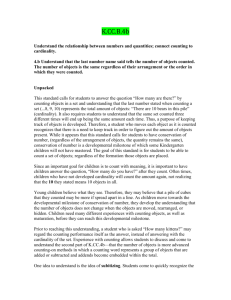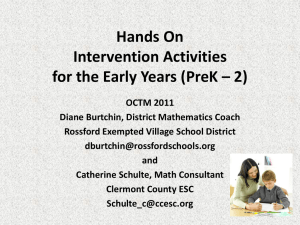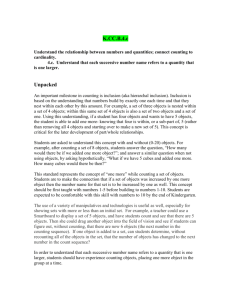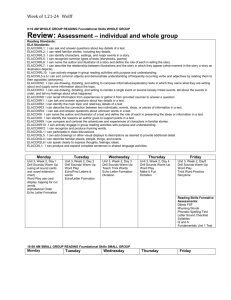Subitizing & Arithmetic Skills: Effects of Daily Practice
advertisement
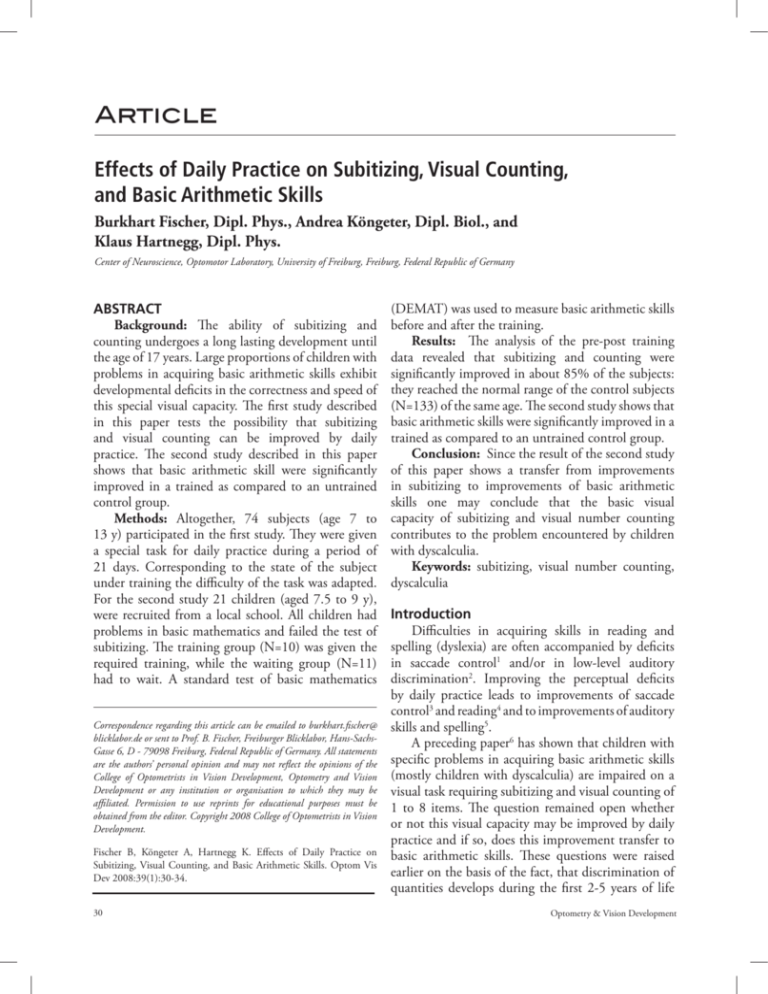
Article Effects of Daily Practice on Subitizing, Visual Counting, and Basic Arithmetic Skills Burkhart Fischer, Dipl. Phys., Andrea Köngeter, Dipl. Biol., and Klaus Hartnegg, Dipl. Phys. Center of Neuroscience, Optomotor Laboratory, University of Freiburg, Freiburg, Federal Republic of Germany ABSTRACT Background: The ability of subitizing and counting undergoes a long lasting development until the age of 17 years. Large proportions of children with problems in acquiring basic arithmetic skills exhibit developmental deficits in the correctness and speed of this special visual capacity. The first study described in this paper tests the possibility that subitizing and visual counting can be improved by daily practice. The second study described in this paper shows that basic arithmetic skill were significantly improved in a trained as compared to an untrained control group. Methods: Altogether, 74 subjects (age 7 to 13 y) participated in the first study. They were given a special task for daily practice during a period of 21 days. Corresponding to the state of the subject under training the difficulty of the task was adapted. For the second study 21 children (aged 7.5 to 9 y), were recruited from a local school. All children had problems in basic mathematics and failed the test of subitizing. The training group (N=10) was given the required training, while the waiting group (N=11) had to wait. A standard test of basic mathematics Correspondence regarding this article can be emailed to burkhart.fischer@ blicklabor.de or sent to Prof. B. Fischer, Freiburger Blicklabor, Hans-SachsGasse 6, D - 79098 Freiburg, Federal Republic of Germany. All statements are the authors’ personal opinion and may not reflect the opinions of the College of Optometrists in Vision Development, Optometry and Vision Development or any institution or organisation to which they may be affiliated. Permission to use reprints for educational purposes must be obtained from the editor. Copyright 2008 College of Optometrists in Vision Development. Fischer B, Köngeter A, Hartnegg K. Effects of Daily Practice on Subitizing, Visual Counting, and Basic Arithmetic Skills. Optom Vis Dev 2008:39(1):30-34. 30 (DEMAT) was used to measure basic arithmetic skills before and after the training. Results: The analysis of the pre-post training data revealed that subitizing and counting were significantly improved in about 85% of the subjects: they reached the normal range of the control subjects (N=133) of the same age. The second study shows that basic arithmetic skills were significantly improved in a trained as compared to an untrained control group. Conclusion: Since the result of the second study of this paper shows a transfer from improvements in subitizing to improvements of basic arithmetic skills one may conclude that the basic visual capacity of subitizing and visual number counting contributes to the problem encountered by children with dyscalculia. Keywords: subitizing, visual number counting, dyscalculia Introduction Difficulties in acquiring skills in reading and spelling (dyslexia) are often accompanied by deficits in saccade control1 and/or in low-level auditory discrimination2. Improving the perceptual deficits by daily practice leads to improvements of saccade control3 and reading4 and to improvements of auditory skills and spelling5. A preceding paper6 has shown that children with specific problems in acquiring basic arithmetic skills (mostly children with dyscalculia) are impaired on a visual task requiring subitizing and visual counting of 1 to 8 items. The question remained open whether or not this visual capacity may be improved by daily practice and if so, does this improvement transfer to basic arithmetic skills. These questions were raised earlier on the basis of the fact, that discrimination of quantities develops during the first 2-5 years of life Optometry & Vision Development and constitutes the beginning of the development of the sense of number7. It was also shown that daily training of several basic number operations speeded subitizing and numerical comparison by several hundred milliseconds8. This paper describes 2 closely related studies. The first refers to the effects of training of the visual task of subitizing and number counting. The second describes the effects of the training on basic arithmetic skills. Methods of Study 1 Subjects: Subjects were selected on the basis of their poor performance in basic arithmetic skills (Zareki, DEMAT) but reached normal reading and spelling levels. The 16-percentile was used as a criterion. General intelligence (IQ) was measured by the Kaufmann ABC or the HAWIK test. Children with IQs below 85 were excluded from the study. Only those which could not perform the test task of visual subitizing and counting within the limits of the age matched controls were included in the study. The test group contained 74 subjects in an age range of 7;0 to 13;11 years. They were divided into 3 different age groups as shown in Table 1. The post-training values of the test group were compared with those of a control group (N=133) in the same age range (s. Table 1). Age Group (years) 7-8 9 - 10 11 - 13 Test (N=74) Number (fem/male) mean age +/- s.d. (years) 25 (10/15) 7,7 +/- 0.5 30 (17/13) 9,4 +/- 0.5 19 (5/14) 11,9 +/- 0.9 Control (N=133) Number (fem/male) mean age +/- s.d. (years) 35 (18/17) 7,5 +/- 0,5 36 (20/16) 9,6 +/- 0.5 62 (36/26) 11,9 +/- 0.8 Table 1: The number of subjects in each age group and their mean values. Visual stimuli, task, and procedure: The visual stimuli used for the training were small circles (items) described in detail in the previous paper. Briefly, 1 to 9 items could be presented in random order. The spatial locations of the items were selected randomly from a 4 by 4 raster. The visual display, the keyboard, and data collection were all implemented in a small hand held instrument. The children were given one instrument each to practice the tasks at home one session every day for 3 weeks. A session lasted about 10 to 20 min. The training tasks were essentially the same as used for the test with the following exceptions: because the Volume 39/Number 1/2008 children could not perform the test task according to their age control group the task was made very easy at the beginning of the training by selecting only item numbers up to 3 and by presenting them for 300 ms (level 1). As the child performed this task better than 80% correct the difficulty was increased by allowing more item numbers and by decreasing the presentation time. In this way 11 levels of difficulty were established. Each training session consisted of 140 trials. At the beginning of the training period each subject had to perform the test task in its original form to collect the pretraining values. Similarly, a test session had to be repeated at the end of the training at day 21. Data collection, variables, and analysis: The data were recorded by the test/training instrument and downloaded to a PC for later analysis. The response time r(N) and the percentage of correct responses p(N) were recorded for each item number N. For each subject we calculated the linear regression between the response times and the item number for N=4 to N =8. For N > 3 an almost linear relationship was obtained for most subjects. The slope of it measures the mean time per item, t. The basic reaction time T was calculated as the mean value of r(1). The mean percentage of the correct responses P was calculated for item numbers between 4 and 8. Note that T characterizes the performance for item number 1, while P and t describe the performance for item numbers between 4 and 8. To compare the performance at the beginning and the end of the training two characteristic variables were compared: the basic response time T and the effective recognition E = P/t. To see the effects of training age curves were plotted for pre- and post-training values of T and E. To characterize subitizing the mean response times (tsim) and percentages of correct responses (psim) were determined for item number 2, 3, and 4. The corresponding effective recognition is calculated by psim/tsim. ANOVAs were run to see whether or not significant training effects were obtained. To estimate the success rate the data from a control group containing 133 subjects were used. They were divided into 3 age groups. Their mean values and standard deviations were used to count the number of test subjects who fall within the control range of 1 standard deviation from the mean value, i.e. above the 16 percentile. 31 beginning of the study, after the training period of the test group, after the following training period of the former waiting group, and after another period, during which all participants went to school without further interventions. Figure 1: Percentage of correct responses as a function of the number of items before and after the training. Data from age group 2. Here and in the following figures the vertical bars indicate standard errors. Figure 2: Basic Responses time as a function of the number of items before and after the training. Data from age group 2. The linear regression line is drawn. Its slope defines the time per item. Methods of Study II The subjects of the second study were recruited from a special class of a single German Grammar School. They were 7.5 to 9 years old and they all had specific problems in basic arithmetic skills and they failed the standard task for subitizing and visual counting. All participants received the same school lessons throughout the duration of the study. The total group of 21 children was divided into 2 groups, one received the training (N=10) the other had to wait (N=11). All participants received a standardized test of basic mathematical skills (DEMAT) at the 32 Results Count curves: Fig. 1 and Fig. 2 show count curves from age group 2 before and after the training. The percentage of correct responses and the response times are shown as a function of item number. By training the percentage of correct responses was increased for item numbers above 4 or 5. The response times were decreased. Note that the decrease was obtained also for item numbers of 1 to 3, while the percentage of correct responses was close to 100% before the training (in this age group) and therefore could hardly become higher. For age group 1 the percentage of correct responses for item numbers 1-3 were about 90% and could be improved to almost 100% by the training. Age curves: Fig. 3 shows the age curves of the effective recognition and the basic response time before and after the training. The increase of the effective recognition and the decrease of the response time can be seen in all age groups. ANOVA results confirm a significant effect of training for the basic response time (F=13.7, p=0.0004) and for the effective recognition (F=8.75, p=0.004). Considering the mean effective recognition (p/r) of small item numbers (2 - 4) describing the subitizing part reveals also a significant training effect, because of the decrease of the responses times (see Fig. 2). Fig. 4 illustrates these training effects showing the corresponding pair of age curves. Success of the training: The percent number of children who reached the range of the normal control children (post-training values within the 16 percentile of the controls) in both variables was estimated as 85,1%. If one requires that only one of the two variables reached the normal range the percent number of successes were estimated as 87,3% for the effective recognition speed and 94,7% for the basic reaction time. Another way of estimating the success rate is to calculate the percent number of children who improved their pre-training value by a certain percentage. Both variables were improved by 5% in 74,3% of the cases. One or the other variable was improved by 5% by another 21,6% of the children. Together, the success rate would be estimated as 95.9%. Optometry & Vision Development Figure 3: Age curves of the effective recognition speed (left side) and basic response time (right side) before and after the training. These considerations show that almost all children can learn the capacity of subitizing and number counting within 3 weeks of daily practice. Transfer to basic arithmetic: The most interesting question was asked by a second study. Is it possible that improvements of subitizing obtained by daily practice have positive effects on basic arithmetic skills? Evaluating the pre-post values of the standardized test (DEMAT) yields the following results. The test group (T-Gr 1) gained 3.2 points while the waiting group (W-Gr 2) lost 0.5 points. Using the two-tailed t-test this difference was significant with p=0.016. The ANOVA resulted in F=6.9, p=0.016. After the first training (and waiting) period the waiting group was also given a 3-week training. Repeating the DEMAT showed that this group now gained 3.3 points (T-Gr 2). The t-test revealed p=0.002. In the same time the former training group gained another 2 points, even though the participants received no further training but just visited school. After another 5 weeks of visiting school the former waiting group gained also another 2 points. Closer analysis showed, that among the 10 subdomains of the DEMAT three were not improved by the test group. The first of them deals with the characteristics of numbers, the second with division, and the third with money. These three are only loosely related to subitizing and number counting. When these variables were excluded from the analysis, the differences between the test group (gaining 4.1) Volume 39/Number 1/2008 and the waiting group (loosing 0.8) became highly significant (p= 0.001) and similarly the transfer effect of the training of the waiting group (gaining 4.0) reached p = 0.002. Fig. 5 illustrates this result. At the very end of the study both groups had gained about 6 points. The fact that not all of the DEMAT-variables were improved by the training argues against the possibility of a significant placebo effect in this study. Figure 4: Age curves of the effective recognition speed for 2, 3, and 4 items (subitizing) 33 Transfer of Training Figure 5: The transfer effects of the training to basic arithmetic skills are shown by the mean differences in scores reached in a standard mathematical test. T-Gr 1 indicates the test group after the training. W-Gr 2 indicates the waiting group after the waiting. T-Gr 2 indicates the former waiting group (2) after the training. to changes due to daily practice. These parietal functions can be altered even at ages well above school age of 6 or 7 years. If the visual capacity of estimating quantities develops early in life on a genetic basis one may argue, that this development was delayed in children with dyscalculia and that they expressed the phenomenon as a consequence of the genetic factor. Yet, any other circumstances, which may have delayed the development of this special parietal function, would also lead to signs of dyscalculia. In any case, it would be important to test a child’s capacity of visual subitizing and number counting and to offer the opportunity of daily practice for improvements. Deficits in subitizing are not selective for children with dyscalculia. Dyslexic children, for example, can also exhibit this kind of deficit but by different amounts and with lower percentages of affected subjects10. Preliminary data show that these dyslexic children can also improve subitizing and visual counting by daily practice, but it is unknown at present, whether the training effects would transfer to reading and/or spelling. The fact that improvements of subitizing and number counting transfer to basic arithmetic skills show that these elementary perceptual and/or cognitive capacities can constitute one reason for problems in learning to deal with numbers. Similarly, dyslexic children can suffer from deficits in basic perceptual auditory, visual and/or saccade control skills. An improvement of these elementary functions frequently transfers to spelling and reading5; 4. Discussion The studies reported here have shown that the basic visual capacity of subitizing and number counting can be improved within a period of daily practice of 3 weeks. The success rate of the training was about 85%. Moreover, the training transferred to basic arithmetic skills. A considerable transfer effect was seen after the training period, while a smaller additional effect was obtained during the post-training period, when the children continued to visit school. This applied to both groups: the training group gained more points due to the additional school lessons they had References M, Fischer B, Hartnegg K. Voluntary saccade control in dyslexia. after their training. The waiting group, who failed to 1. Biscaldi Perception 2000; 29: 509-521. gain any points from school lessons before they were 2. Fischer B, Hartnegg K. On the development of low-level auditory trained, gained more points after their training and discrimination and deficits in dyslexia. Dyslexia 2004: 105-118. still more after another period of school lessons. 3. Fischer B, Hartnegg K. Effects of visual training on saccade control in dyslexia. Perception 2000: 531-542. Although a placebo group was not included in this study it is very unlikely, that general effects of the 4. Fischer B, Hartnegg K. Auditory, visual, and optomotor development, and training in dyslexia. In: Tobias DT (ed), Trends in dyslexia research. New training have led to the improvements in arithmetic York: Nova Biomedical Books, 2004. skills. First, not all domains of the DEMAT test were 5. Schäffler T, Sonntag J, Fischer B. The effect of daily practice on low-level effected by the training. Furthermore, the visual auditory discrimination, phonological skills, and spelling in dyslexia. Dyslexia 2004: 119-130. capacities of subitizing and number counting are low-level basic visual functions, probably not under 6. Fischer B, Gebhardt C, Hartnegg K. Subitizing and visual counting in children with problems acquiring basic arithmetic skills. Optom Vis Dev control of psychological factors. Thus, this study 2008:24-29. confirmed the idea of Dehaene7, who discussed that 7. Dehaene S. Jeder hat ein Gespür für Mathe. Gerin und Geist 2005: 65-67. one reason for the problems in dyscalculia, is the poor 8. Wilson A, Revkin SK, Cohen D, Cohen L, Dehaene S. An open trial development of the sense of number on the basis assessment of “The Number Race”, an adaptive computer game for remediation of dyscalculia. Behavioral and Brain Functions 2006: 20-36. of subitizing. Furthermore, if one looks at the evidence of parietal 9. Dehaene S, Piazza M, Pinel P, Cohen L. Three parietal circuits for number processing. Cogn Neuropsychology 2003: 487-506. functions being involved in number processing9 it B. Subitizing and counting by visual memory in dyslexia and follows from the present study, that the effectiveness of 10. Fischer dyscalculia: Development, deficits, training, transfer. In: Hayes CB (ed), neural connectivity in the parietal cortex is subjected Dyslexia in children: New research. Nova Publishers, 2006. 34 Optometry & Vision Development
